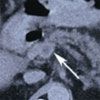Mesenteric Venous Thrombosis
A 63-year-old man with a history of hypertension and gastroesophageal reflux disease presented with progressive, sharp mid-abdominal pain of 3 weeks' duration.

Figure 1

Figure 1

Figure 2
A 63-year-old man with a history of hypertension and gastroesophageal reflux disease presented with progressive, sharp mid-abdominal pain of 3 weeks' duration. The pain was accompanied by nausea but was not associated with fever, chills, vomiting, diarrhea, con- stipation, melena, or hematochezia. His symptoms did not worsen with food consumption. Over-the-counter analgesics provided no relief.
The patient was afebrile and hemodynamically stable. He had mild abdominal distention and diffuse tenderness, without rebound or guarding, in the mid-epigastric region. Bowel sounds were hypoactive; no bruits or pulsatile masses were noted. Initial laboratory evaluation and abdominal imaging results were unrevealing. Results of esophagogastroduodenoscopy were negative.
During his hospital admission, the patient's pain and abdominal distention worsened. Laboratory tests revealed leukocytosis (white blood cell count, 15,800/µL), an anion gap of 18 mEq/L, and a serum lactate level of 25.2 mg/dL.
Repeated abdominal CT showed thrombosis of the superior mesenteric vein and fluid around the spleen (Figure 1). The thrombus extended into the portal vein. An abdominal angiogram demonstrated thrombosis of the superior mesenteric vein as well as diffuse venous collaterals, consistent with subacute mesenteric venous thrombosis (Figure 2).
The patient's status gradually improved with bowel rest, antibiotic therapy, and systemic anticoagulation. He was discharged on hospital day 10 (when he was able to tolerate an oral diet), and lifelong warfarin therapy was started.
The patient denied any family history of thrombotic disease; however, he was ultimately found to be heterozygous for the factor V Leiden mutation.
MESENTERIC ISCHEMIA: AN OVERVIEW
Mesenteric venous thrombosis represents 5% to 15% of all mesenteric ischemia cases.1,2 Of these, the superior mesenteric vein is most commonly involved (95%).3 The condition frequently affects persons during the sixth and seventh decades of life.4
Etiology. Inherited states of hypercoagulability-including activated protein C resistance (factor V Leiden mutation), the prothrombin 20210 mutation, deficiencies in proteins C and S, and decreased antithrombin III levels-represent a major contributing factor in the development of mesenteric venous thrombosis.2,3,5 Acquired states of hypercoagulability, such as paroxysmal nocturnal hemoglobinuria and myeloproliferative syndromes, are also associated with mesenteric venous thrombosis, as are conditions that lead to portal hypertension and intra-abdominal sepsis.2,3,5
Diagnostic findings. Clinical manifestations of mesenteric venous thrombosis are variable and largely depend on the location and extent of the initial thrombus, the duration of intestinal hypoperfusion, and the underlying predisposing condition. Patients classically present with periumbilical pain of sudden onset that is out of proportion to physical examination findings. Additional symptoms may include nausea, vomiting, diarrhea, and hematochezia.
Laboratory studies may reveal leukocytosis, elevated levels of serum lactate, and metabolic acidosis.2 Most of these findings are nonspecific and rarely confirm the diagnosis.
Radiographic imaging confirms the presence of a thrombus. Plain films generally reveal nonspecific changes (such as dilated loops of bowel with air-fluid levels) and can show whether free air is present-a finding that mandates emergent surgical evaluation. Contrast-enhanced CT may demonstrate bowel wall thickening, pneumatosis intestinalis, and vascular occlusions.2,6 Magnetic resonance angiography (MRA) has evolved over the past few years and now rivals conventional angiography. It is possible to visualize the anatomy and determine patency as well as flow rates of the mesenteric arteries and veins with MRA; however, it is less useful in the evaluation of smaller or more distal mesenteric vasculature.6 Conventional angiography is helpful when the presence of thrombosis cannot be confirmed with noninvasive imaging modalities alone or when thrombolytic therapy is used.2,3,6,7
Treatment. The primary goal is to restore intestinal blood flow; however, supportive care in the form of gastric decompression, hemodynamic stabilization, antibiotic administration, and the correction of metabolic disturbances is equally important to a successful outcome. Other goals of treatment are to identify the underlying cause of the thrombosis and to prevent further recurrence.
Clinically stable patients can be treated with supportive care and systemic anticoagulation. Thrombolytic therapy has been used on occasion; however, it is reserved for clinically stable patients with confirmed thrombosis of large mesenteric veins.2,5,8 Patients who exhibit signs of peritonitis require immediate surgical exploration.3
Prognosis. The high mortality associated with mesenteric venous thrombosis is attributable to delayed diagnosis. For those who receive prompt treatment and lifelong anticoagulant therapy, the prognosis is fairly good.
References:
REFERENCES:
1.
Choudhary AM, Grayer D, Nelson A, Roberts I. Mesenteric venous thrombosis: a diagnosis not to be missed!
J Clin Gastroenterol.
2000;31:179-182.
2.
Kumar S, Sarr MG, Kamath PS. Mesenteric venous thrombosis.
N Engl J Med.
2001;345:1683-1688.
3.
Sreenarasimhaiah J. Diagnosis and management of intestinal ischaemic disorders.
BMJ.
2003;326: 1372-1376.
4.
Abdu RA, Zakhour BJ, Dallis DJ. Mesenteric venous thrombosis-1911 to 1984.
Surgery.
1987;101: 383-388.
5.
Divino CM, Park IS, Angel LP, et al. A retrospective study of diagnosis and management of mesenteric vein thrombosis.
Am J Surg.
2001;181:20-23.
6.
Bradbury MS, Kavanagh PV, Bechtold RE, et al. Mesenteric venous thrombosis: diagnosis and noninvasive imaging.
Radiographics.
2002;22:527-541.
7.
Stadler M, Bleck JS, Gebel M. Mesenteric venous thrombosis.
N Engl J Med.
2002;346:1252-1253.
8.
Ross H, Feingold ML, Train JS. Mesenteric venous thrombosis.
N Engl J Med.
2002;346:1252-1253.